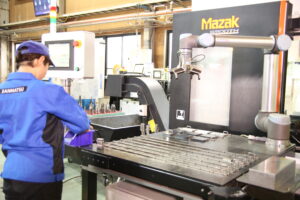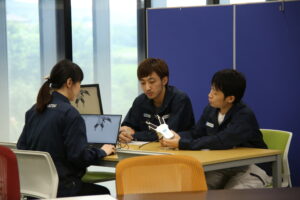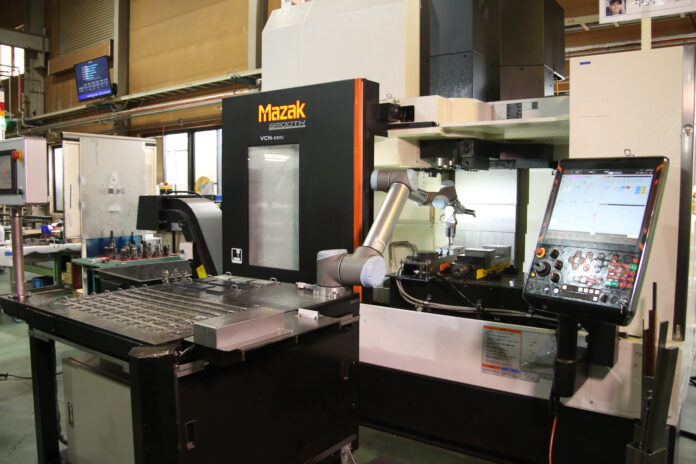SANMATSU Co., Ltd. is an innovative metalworking and equipment development company based in Fukuoka, Japan that specializes in high mix/low volume (HMLV) manufacturing of inspection and measurement devices. The company’s small-lot contract manufacturing business sees it produce more than 100,000 items a month, of which around 70% are one-piece productions with OnRobot Dual Gripper.
 Machine tending challenge
Machine tending challenge
SANMATSU had replaced two machine tools with one machining center (MC) in an effort to conserve floor space and improve productivity. However, due to the nature of its production processes the company was unable to get the most out of the high-performance machining center.
The MC takes 5 to 10 minutes to fabricate one part. That means every 5 to 10 minutes, parts had to be switched out by extracting the fabricated part and setting a new one. In a 10-hour day, the MC can fabricate hundreds of parts, each with different specifications. However, there were complaints from the manufacturing floor that workers had to “stand by and watch over the MC whenever it’s running,” says Mr. Tetsuro Tanabe, President/CEO of SANMATSU. This process was unergonomic and inefficient, which led the company to explore automation.
“Just installing an MC won’t move our innovation forward? Well then, let’s add an external cobot to the MC. We thought that automated machine tending, with a robot to place and extract parts at an MC or machine tool, would help us proceed,” explains Tanabe.
 OnRobot Dual Gripper Collaborative application solutions
OnRobot Dual Gripper Collaborative application solutions
From the outset, SANMATU decided to look for a collaborative application to free their workers from monitoring the MC and solve their machine tending challenges. Collaborative applications are industrial robot applications that use collaborative robots (cobots) or lightweight industrial robots. Collaborative applications are paradigm-changing in terms of the way automation is deployed in real-world settings because they enable humans and robots to safely collaborate in the same workspace. In addition, lightweight industrial robots and cobots are significantly cheaper and easier to use than traditional industrial robots, which makes collaborative automation attractive to companies of all sizes, including those with limited budgets for new equipment. Further, since cobots can be deployed without the need the fencing—after a risk assessment—cobot-powered solutions provide automation with a small, space-saving footprint.
“Our customers are small and medium-sized manufacturers, and they all say to us, ‘If you have to make a safety fence, then you don’t need a robot.’ It’s extremely important for small and medium-sized manufacturers to conserve space, save on installation costs, and cut down on the work of operating robots by not having a safety fence in the first place,” says Tanabe.
 Gripping solution
Gripping solution
When looking for collaborative application solutions, SANMATSU carefully compared several different companies.
“We also heard that OnRobot products have a great interface and programming them is simple,” notes Tanabe. By downloading software through the USB connection on the robotic arm’s control panel, an operator can display basic commands and quickly configure the equipment.
SANMATSU finally chose to deploy OnRobot’s RG6 Dual Gripper on a cobot from Universal Robots. The company was attracted to the RG6’s stroke, load capacity, and dual gripper capabilities. With a 160mm max stroke and 6kg load max capacity, the RG6 Dual Gripper can handle diverse parts of different sizes and weights. Although the parts themselves are thin sheet metal, the ability to take advantage of a large stroke and load capacity is essential for HMLV production.
Furthermore, while an MC fabricates, the RG6 Dual Gripper is on standby holding the next part. After fabrication, the sliding door opens, the empty gripper takes out the finished part, and the other gripper sets the new part. By extracting and setting in one step, it cuts the wait time for switching out MC parts roughly in half.
Shoko Toyota, from the Solution Development Group at SANMATSU explains that OnRobot products are especially easy-to-use “because, in addition to the guaranteed plug-and-produce capability provided by UR+, it’s compatible with complex programs since you can write a script to enable accurate control from a PLC.”
“When automating an HMLV production site with robots, OnRobot products check all the right boxes. They don’t require daily instruction and they allow you to cover a wider range of work, and that has been a huge help,” adds Toyota.
Smooth production and cost savings
The automation deployment has enabled SANMATSU to continue production after regular working hours, explains Shinichi Miyata, Team Head, Microfabrication Team, Machinery Group: “We do the work that has to be performed by people during the day, and after regular working hours, we leave it to the robot and go home. We can do this without a lot of overtime. And since we can use automated operation at night when we are busy, I really feel we are making better use of the MC’s capabilities than ever before.”
Since human workers don’t have to attend to the MC all the time, “production site stress” –and costs—have been reduced, says Tanabe: “On the cost front, since automation allows for more unmanned MC fabrication hours, production costs are down by about 10%.”
Because SANMATSU performs complicated production processes where each item has its own specifications, the company used to make mistakes due to causes such as setting a part incorrectly. Since deploying the OnRobot gripper, the number of defective parts has decreased significantly.
 Automation with cobots is a no-brainer at HMLV production sites for SMEs
Automation with cobots is a no-brainer at HMLV production sites for SMEs
Following the successful RG6 dual gripper deployment on machine tending applications, SANMATSU has plans to expand its investment in collaborative automation, says Miyata: “We first applied automation to this MC, and the introduction of cobots has proven that doing so yields solid results by improving productivity, reducing manual labor, and decreasing production costs. I think we can also apply it to other machine tools such as lathes. There are lots of other processes I want to automate, so I want to use it in more of our work, in consultation with our program developers.”
Meanwhile, speaking about SANMATSU’s ambitious business and automation expansion plans, Tanabe comments: “Our success with installing robots and collaborative automation, even though we have a thoroughly HMLV production site, is something I would like to show a wider range of customers. At the moment, there are specific needs for machine tending in the food products and medical industries, but I want to conduct more research and try out some different things so that our robots can grab soft, delicate items.”
Knowledge gained during the COVID-19 pandemic is a significant driver for SANMATSU’s future automation plans, adds Tanabe: “A factory cannot be run completely remotely, and that also goes for when the unexpected happens. Even so, it seems that it will be essential for factories to make an active effort to further automation and to be flexible and prepare in advance for unanticipated situations. The combination of the OnRobot Gripper and collaborative applications is an appealing option because it’s easy to install after you’ve already set up other equipment. I think all small and medium-sized factories in all businesses should consider installing them.”









































